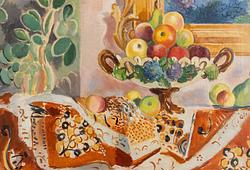Axel Törneman
"Trappan".
Signed AT and dated 1901. Relined canvas 96 x 85 cm.
Provenance
Gallery Moser & Klang, Stockholm.
Private collection.
Exhibitions
Gallery Moser & Klang, Stockholm, "Axel Törneman 1880-1925", 1985.
Leighton House Museum, London, "Axel Törneman. An eccentric Swedish colourist", 17 May - 1 June 1989, cat. no. 2.
Literature
Leighton House Museum, London, "Axel Törneman. An eccentric Swedish colourist", exhibition catalogue, 1989, illustrated p. 14.
More information
After completing his studies at Norra Latin and Stockholm’s Private Gymnasium, Axel Törneman chose to pursue a career as an artist. In 1899, he began his studies at Valand School of Painting under Carl Wilhelmson. Although his time at Valand was brief, it proved decisive for his later artistic development; under Wilhelmson’s guidance, he learned to depict the lives of working people with clear, pure colors and a direct presence that would follow him throughout his career.
In 1900, Törneman continued his studies in Munich, where he attended the Academy of Fine Arts and drew inspiration from the flowing lines and symbolic motifs of Jugendstil. After Munich, he moved to Dachau, where he became involved with an international artists’ colony under the direction of Adolf Hölzel. There, Törneman developed a synthesis of the suggestive imagery of symbolism with a forceful, expressionist approach to color. One of his best-known paintings from this period is The Blind, which is now part of the collection at Värmland Museum.
From the same period comes the auctioned painting The Stairs (1901), an example of Törneman’s early symbolist style.
"This range of different styles of teaching, and the contrasting examples of work to which Törneman was exposed, produced in him a synthesis of Germanic symbolism and a forceful Expressionist technique. Unfortunately, most of the paintings from this early phase of the artist's career are lost; one example to survive is The Stairs [cat. no. 2] of 1901, in which a a gnarled tree trunk rises up before a flight of steps leading to an imposing building. The ghostly figure of a girl, which he had perhaps intended to eliminate by over-painting, appears in the foreground. The work is done in a range of blues and greys, and is suggestive of nightfall". (Utdrag ur "Axel Törneman. An eccentric Swedish colourist", s. 2.)



















































